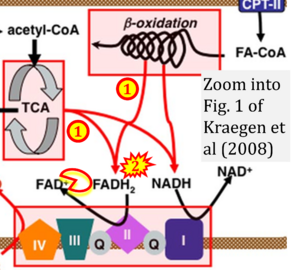Kraegen 2008 Proc Natl Acad Sci U S A
| Kraegen EW, Cooney GJ, Turner N (2008) Muscle insulin resistance: a case of fat overconsumption, not mitochondrial dysfunction. Proc Natl Acad Sci U S A 105:7627-8. https://doi.org/10.1073/pnas.0803901105 |
Kraegen EW, Cooney GJ, Turner N (2008) Proc Natl Acad Sci U S A
Abstract: Insulin resistance—an impairment in the ability of insulin to appropriately regulate glucose and lipid metabolism—is an early and key defect associated with weight gain (obesity), type 2 diabetes (T2D), and other disorders of metabolism. The etiology of insulin resistance is still not completely understood, but it is now clear that a strong association exists between insulin resistance and excess lipid accumulation in nonadipose tissues, particularly muscle and liver. Whether muscle cytosolic lipid accumulation causes insulin resistance still requires definitive proof, but highly plausible mechanisms have been elucidated supporting this possibility. These mechanisms involve links between metabolically active cytosolic lipid intermediates, such as diacylglycerols and ceramides, and specific steps in insulin signaling (1) (see blue shaded box in Fig. 1). Certainly we know that excess dietary fat intake in animals over the course of several weeks (or acute pharmacological elevation of circulating fatty acids over several hours) can cause muscle insulin resistance and that both conditions are accompanied by cytosolic lipid accumulation. Tissue accumulation of lipids could occur as a result of increased fatty acid uptake, a decreased rate of fatty acid utilization, or a combination of both. Accordingly, there has been considerable interest in recent reports that have used a variety of techniques (e.g., gene expression, 31P-magnetic resonance spectroscopy, histological analyses) to indicate that insulin-resistant, obese, or T2D subjects have a reduced mitochondrial content and/or impaired mitochondrial function (2, 3). The conclusion from many of these studies is that mitochondrial dysfunction could be a major factor contributing to muscle lipid accumulation and insulin resistance. However, an important study by Hancock et al. (4) in this issue of PNAS shows that insulin resistance can develop in animals in response to the feeding of high-fat diets, despite a significant increase in mitochondrial content.
• Bioblast editor: Gnaiger E
Correction: FADH2 and Complex II
- FADH2 is shown as the substrate feeding electrons into Complex II (CII). This is wrong and requires correction - for details see Gnaiger (2024).
- Gnaiger E (2024) Complex II ambiguities ― FADH2 in the electron transfer system. J Biol Chem 300:105470. https://doi.org/10.1016/j.jbc.2023.105470 - »Bioblast link«
Labels: Pathology: Obesity
Enzyme: Complex II;succinate dehydrogenase


